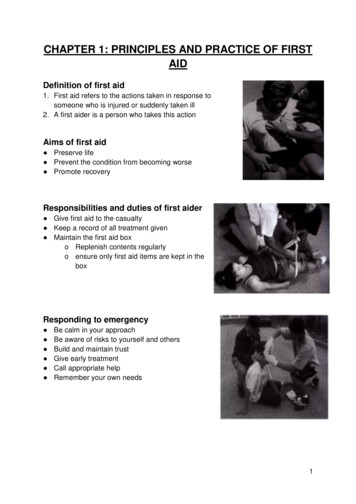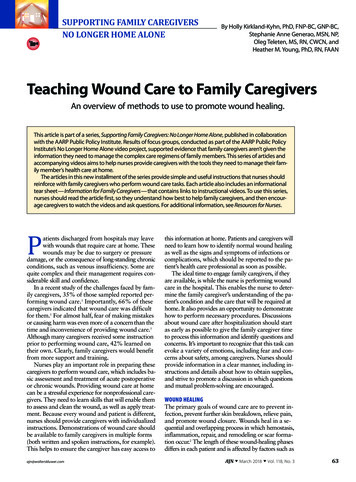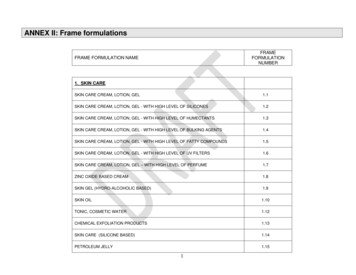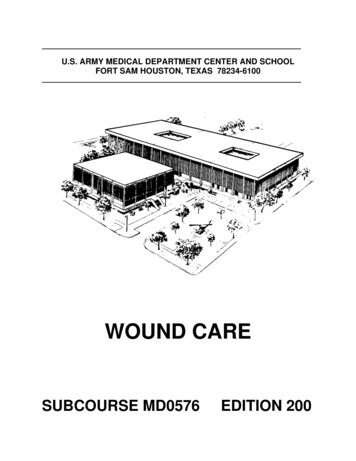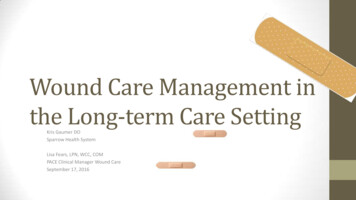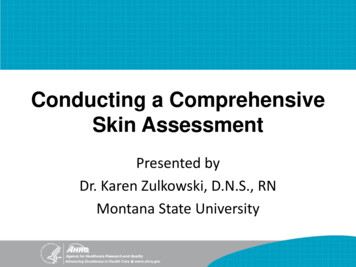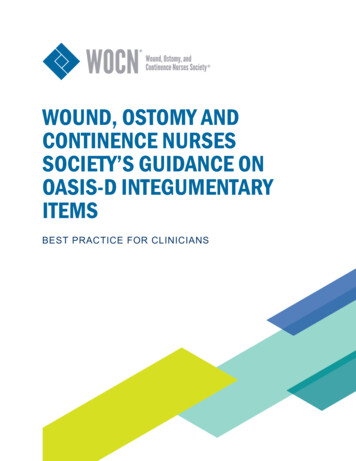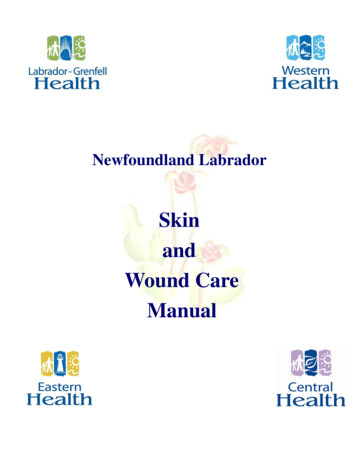
Transcription
Newfoundland LabradorSkinandWound CareManual
Newfoundland LabradorSkinandWound CareManualJuly 2008An initiative undertaken by theSkin and Wound Care Specialistsof the Regional Health Care Authorities
AcknowledgementsCarla Wells, RN, PhD(C), ET, GNC(C). Skin and Wound Management Consultant;Member of Faculty, Western Regional School of NursingWho provided expert research culminating in the initial draft of the firstProvincial Skin and Wound Care Manual.Lynn Power, RN, MN, Nursing Practice ConsultantAssociation of Registered Nurses of Newfoundland and LabradorWho developed the first Advanced Wound Care Manual for the Health Care Corporation of St. John’s in2003. The contents of this manual were used to inform the work and production of this manual.Newfoundland and Labrador Health Boards AssociationFor their generous financial support for the project.Provincial Skin and Wound Care Specialist Working GroupFor their expert advice.(* denotes past members)Eastern Health: Louise Jones, Past-Chair*; Norma Baker, Chair; Margo Cashin; Renee Dobbin*; Gillian Duff;Debbie Farrell; Doris Lewis; Lana Mah; Annette Morgan; Rhonda O’Driscoll; Patricia Osmond; Vivian Wass*Central Health: Colleen Beson*; Petrina Blanchard; Delilah Guy; Brenda Howell*; Nancy WrightWestern Health: Mary Beresford; Ann Doyle*; Sherry McCarthyLabrador Grenfell: Madonna Chaulk*; Rhonda Hicks*; Sharon Penney*; Terri-Lynn Ricketts*; DelphineRoberts*; Jayne Rowsell; Beverley Woodford*.Association of Registered Nurses of Newfoundland & Labrador: Lynn PowerOffice of the Chief Operating Officer—Adult Acute Care (St. John’s), Eastern Healthand the former Nursing Leadership CouncilFor providing vision, leadership and administrative support during the project.Coloplast, ConVatec, and Carla WellsFor the use of graphics contained herein.Mary Bayfield Kelly and Claude BelangerFor Copyright of the Pitcher Plant (Cover).Print Shop—St. Clare’s Mercy Hospital, Eastern HealthFor printing of the Provincial Skin and Wound Care Manual.
Newfoundland and Labrador Skin and Wound Care ManualTable of ContentsJuly 2008SectionPage1.0INTRODUCTION AND BACKGROUND2.0WOUND HEALING2.1Skin2.23.04.02.1.1Anatomy & Physiology of Skin2.1.2Functions of the Skin2.1.3Physiological Changes in Aging SkinTypes of Tissue Injury2.2.1Types of Tissue Injury2.2.2Nursing Strategies to Prevent Skin Problems2.2.3Physiology of Wound Healing2.2.4Types of Wound Healing2.2.5Factors Affecting Wound HealingNUTRITIONAL FACTORS IN WOUND MANAGEMENT3.1Biology of Wound Healing3.1.1Specific Nutritional Requirements3.1.2Hydration Status3.1.3Nutritional Screening/Assessment3.2Risk Factors for Malnutrition and Wound Complications3.2.1Admission Diagnoses3.2.2Weight Status3.2.3Biochemical Indicators3.3Risk Assessment Tool3.4Therapeutic Plan3.4.1Nutritional Protocol for Pressure Ulcer Healing3.5Nutritional Outcome Monitoring3.6Patient Education Pamphlet3.7ConclusionAppendix 1 – Nutrition Protocol for Pressure Ulcer HealingAppendix 2 – Nutritional Outcome Measurement Template forWound ManagementAppendix 3 – Nutrition and Wound Healing PamphletPRINCIPLES OF WOUND HEALING134557710101266667891010131313
sk Assessment and PreventionWound Assessment and Documentation ToolWound n and Elimination of Infection4.5.1Signs and Symptoms of Infection in ChronicWounds4.5.2Diagnosis of Infection4.5.3Identification of Infection4.5.4Guidelines for Swab Culture4.5.5Local versus Systemic Infection4.5.6Treating InfectionsElimination of Dead SpaceAbsorption of ExudatePromotion of Moist Wound HealingPromotion of Thermal InsulationProtection of the Healing WoundBRADEN RISK ASSESSMENT AND INTERVENTIONS5.1Braden Scale5.2Braden Scale for Predicting Pressure Sore Risk5.3Braden Scale – CopyrightAppendix 1 – Nursing PolicyAppendix 2 – Braden ScaleAppendix 3 – CopyrightPREVENTION AND MANAGEMENT OF WOUNDS6.1Pressure terventions6.1.5Evaluation6.1.6Prevention of Pressure Ulcers6.2Leg Ulcers6.2.1Venous Leg Ulcers6.2.2Arterial Leg Ulcers6.3Diabetic Foot Ulcers6.3.1Assessment6.3.2Semmes-Weinstein 920
6.3.5Evaluation6.3.6PreventionSurgical Wounds6.4.1Methods of Surgical Wound Closure6.4.2Dressings for Surgical Wounds6.4.3Surgical Wound Healing6.4.4Surgical Site .1Severity of Burn Wound6.5.2Long Term Management of Burns6.5.3Objectives for the Care of Burn Wounds6.5.4Guidelines for Minor Burn Wound Care6.5.5Burn Unit Referral CriteriaOncology ns6.6.4Pain Management6.6.5Odor Management6.6.6Debridement6.6.7Exudate Control6.6.8Evaluation6.6.9Quality of LifeAppendix 1 – Determination of Ankle Brachial IndexAppendix 2 – Diabetic Foot Screen for Loss of 72829293030313132323232WOUND ASSESSMENT AND DOCUMENTATION7.1Wound Assessment Policy7.2Wound Assessment RecordAppendix 1 – Wound Assessment Record1128.0PRODUCTS AND PRODUCT CATEGORIES8.1Wound Care Products8.2Wound Care Product CategoriesAppendix 1 - Wound Care Product TablesAppendix 2 - Company Index11389.0DATA COLLECTION AND REPORTING9.1Chart Audit of Braden Skin and Risk Assessment9.2Wound Care Best Practice Chart Audit11
SectionPage9.310.0Incidence Tracking of Various Types of WoundsAppendix 1 – Braden & Risk Assessment Chart AuditSPECIAL PROCEDURES10.1Negative Pressure Wound Therapy Systems10.2Silver Nitrate11.0GLOSSARY OF TERMS12.0BIBLIOGRAPHY13.0CONCEPTUAL MODEL – Provincial Skin and Wound Care Program113
Section 1.0INTRODUCTION & BACKGROUNDSkin and Wound Care is a major health care concern that affects many individuals with different typesof wounds and consumes vast resources. Wounds have varying effects on the quality of life of thoseaffected, their families and caregivers. Providing skin and wound care is a major commonconsideration in the day to day caring of patients with wounds whether in acute, long term orcommunity based environment.The Provincial Skin and Wound Care Manual will: Provide a full understanding of the wound healing process and how this affects patientsgeneral state of health.Identify risk factors affecting the wound healing and delaying process.Focus and apply the wound care principles based on evidence best practices.Identify/adapt strategies/measures in preventing wound re-occurrences.Increase knowledge on building technical skills about wound assessment anddocumentation.Familiarize with the current, innovative wound care technology.Select and apply the appropriate products pertinent to all types of wounds.Promote ongoing wound care education programs.Gain self-empowerment.For the past two decades, many changes have occurred in the art of science on how wounds aremanaged. There has been great advancement in wound technology, research and development ofsound policies and standards of care based on research and clinical evidence to achieve positiveoutcomes in wound healing.Effective skin and wound management is built upon on how the clinician understands the processes ofwound healing and is able to incorporate the knowledge and theory into practice. The clinician shouldalso have the ability to identify and interpret when the wounds are failing to heal.Successful wound management greatly depends on the collaboration and the integration of an intermultidisciplinary health care team approach. Having the coordinated approach can improve positiveoutcome through education, research, standardization and positively create a consistent delivery ofevidence-based practices in wound care.This manual is intended not only for the clinician involved in skin and wound care and other health careprofessionals, but for anyone who has the interest and passion in wound caring.This manual will be an invaluable resource to all involved in skin and wound care.Newfoundland and Labrador Skin and Wound Care Manual – July 2008Section 1 - Page 1
For purposes of this Provincial Skin and Wound Care Manual, the term “clinician” is used to describeany health professional who is involved with providing wound care to a client.Newfoundland and Labrador Skin and Wound Care Manual – July 2008Section 1 - Page 2
Section 2.0WOUND HEALINGIn Section 2, the reader is introduced to the topics of skin and wound healing. The normal phasesof wound healing are described. Factors that may interfere with the wound healing process arealso discussed.Wound healing is a complex series of events that begin when an individual develops a wound.Regardless of the nature of a wound, the same healing steps occur. A wound moves through aseries of phases as it heals and the clinician’s role is to support the wound healing process throughproper assessment and treatment.2.1SKIN2.1.1Anatomy & Physiology of SkinSkin is the largest and most visibleorgan of the body, comprising up to 1520% of the total body weight. It receivesapproximately one third of the body'sblood supply at a rate of 300mls/minute.Normal skin is composed of two layers:epidermis and dermis. Under the dermislies the subcutaneous tissue (orhypodermis), a layer of loose connectivetissue. Epidermiso Thin, avascular, stratified, outermost layer of the skin. Ranges in thicknessfrom 0.04 mm (eyelids) - 1.6 mm (soles of the feet and hands).o Composed of five layers of epithelial cells (squamous cells) eachgradually differentiating into the next layer such that the final layerconsists of dead, hardened, mature cells which are eventually shed as aresult of external friction.o The process of differentiation or regeneration of the epidermal layer isstimulated by growth factors. It takes approximately 3-4 weeks.o The primary cells in this layer are Keratinocytes (protein producing cells)and Melanocytes (color producing cells).o The primary functions of this layer are Protection and Regulation.Newfoundland and Labrador Skin and Wound Care Manual – July 2008Section 2 - Page 1
Basement Membrane Zoneo Separates the epidermis from the dermis. Sometimes called theepidermal-dermal junction.o Dermal papillae called rete pegs lock the epidermis and dermis together ina tongue and groove fashion.o Consists of proteins, fibronectin (aids in water retention and adhesion ofhealing elements) and non-fiber forming collagen (adds thickness to theskin).o Anchors the epidermal appendages e.g. sweat glands & hair follicles. Dermiso Is the layer between the Epidermis and the Subcutaneous Tissue.o Ranges in thickness from 1 mm - 4 mm. The most dense area is on theback.o Contains blood vessels, nerve fibers, lymphocytes, sweat and sebaceousglands, and hair follicles.o Main proteins present are collagen (which provides strength) and elastin(which is responsible for skin’s ability to recoil back into shape).o Contains the cells primarily responsible for wound healing: fibroblasts(secrete collagen), mast cells (initiate the inflammatory response), andlymphocytes (protect by controlling microbial invasion). The primaryfunctions of this layer are strength, nutrition and structural support. Subcutaneous Tissueo Supports and anchors the Epidermis and Dermis to the underlying bodytissue.o Sometimes called the Hypodermis.o Age, heredity, and nutritional intake influence the thickness of this layer.o Consists of connective tissue and adipose tissue. Stores approximately50% of the body's fat supply.o The primary functions of this layer are protection, insulation, energy, andbody shape. pH of SkinThe normal skin pH is 5.5. pH is a chemical symbol for the measurement ofhydrogen ions in solution or the measurement of the acid-alkali units in a givensubstance. All of nature’s and human chemicals are either acidic, alkaline orneutral. A skin pH of 5.5 means that the skin is acidic. If skin comes in contactsomething that has a pH outside of its normal range, the potential for harm tothe skin is present. The closer something gets to a pH of 1 or a pH of 13, themore acidic or alkaline it becomes and it has the potential to cause seriousburns to skin.Newfoundland and Labrador Skin and Wound Care Manual – July 2008Section 2 - Page 2
2.1.2. Functions of the SkinThe skin has six major functions. They are protection, thermoregulation,elimination of waste products, synthesis of Vitamin D, sensation andcommunication.1.Protection – the epidermis acts as a barrier to protect underlying tissuefrom mechanical injury, dehydration and the effects of harmfulsubstances. It also prevents many disease causing organisms fromentering the body.2.Thermoregulation - capillaries in the dermis dilate and constrict inresponse to heat and cold. This process results in increased ordecreased blood flow to the skin leading to a greater or lesser loss of bodyheat.3.Elimination of Waste Products (Excretion) - cellular waste products areexcreted via the sweat glands.4.Synthesis of Vitamin D - Vitamin D is synthesized by the skin in thepresence of ultraviolet radiation from the sun.Newfoundland and Labrador Skin and Wound Care Manual – July 2008Section 2 - Page 3
2.1.35.Sensation - nerve endings that enter through the dermis provide skinsensations of pain, cold, heat, touch and pressure.6.Communication – skin serves as an organ of communication andidentification. The skin over the face is important for identification of aperson and plays a role in internal and external assessments of beauty.Scarring can affect self-image. Facial skin and underlying muscles arecapable of expressions of smiling, frowning, and pouting.Physiological Changes in Aging SkinThere are numerous changes to aging skin. They include: fewer active basal cells in the epidermis resulting in a thinning of theepidermis.slower cell turnover, resulting in slower healing.fewer Langherhan cells, which result in a delayed inflammatory response.tactile sensitivity lessens and patients experience reduced acuity of painperception.Major visible changes are also evident. They include: wrinkles, lines and sagging caused by loss of subcutaneous fat.pressure dissipation is reduced because of loss of subcutaneous fat.bruising - circulation in skin is less efficient. Vascular walls become thinnerand fragile and the skin bruises more easily.liver or age spots - melanocytes are lost at a rate of 20% per decade after theage of 30. Those left behind clump to form irregular aggregates.skin tears - dermo-epidermal junction is flattened, therefore the two layersbecome less secure.Newfoundland and Labrador Skin and Wound Care Manual – July 2008Section 2 - Page 4
2.2TISSUE INJURY2.2.1Types of Tissue InjuryType of InjuryEnvironmentalIrritantWindTemperature earPressureEpidermal StrippingChemicalFecal IncontinenceHarsh solutionsDrainageMany factors are known to damage skin. Injuries can occur from environmental,mechanical, and chemical irritants. The impacts of these irritants are outlinedbelow. Environmental Injurieso Wind – wind can have an excessive drying effect on the skin, leaving itmore at risk of breakdown.o Temperature Irregularities – excessive cold can cause injury to skin inthe form of frost nip or frostbite. A wind-chill temperature of -22 C cancause frostbite in 15 minutes.o Humidity – excessive moisture on the skin can cause alteration in the pHbalance of the skin and can cause maceration, leaving the skin at risk ofbreakdown.o Sunlight – sunburn can result from even a short-term exposure toultraviolet radiation (UVR). Exposure to UVR can lead to skin cancer,sunburn (first or second-degree burns), compromised immunity, and longterm skin damage. Mechanical Injurieso Friction – Friction alone can also cause skin breakdown from twosurfaces rubbing together. This can be two body parts rubbing together orfrom a body part, such as a heel rubbing on a mattress. The skin has theappearance of an abrasion or a blister. Common sites include the heelsand elbows.Newfoundland and Labrador Skin and Wound Care Manual – July 2008Section 2 - Page 5
o Shear force – This is created by the interaction of both gravity and friction(resistance) against the surface of the skin. Friction is always presentwhen shear force is present. Shear force injuries cause significantly moredevastating results because the damage usually starts at the level of thebone or deep tissue and then becomes evident later on the surface of theskin. A classic example of shearing occurs when a patient is sitting in asemi-fowlers position. As the patient slides downward towards the foot ofthe bed, the bed surface generates enough resistance that the skin overthe sacrum remains in the same location. Ultimately, the skin is held inplace while the skeletal structure pulls the body toward the foot of the bed.The blood vessels in the area are stretched and angulated and suchchanges may create small vessel thrombus and tissue death. This oftenoccurs when the head of the bed is too high, above 30o, or when a patientis transferred using improper transferring techniques.o Pressure - the most common form of mechanical damage. Whenexternally applied pressure exceeds capillary closing pressure, capillaryocclusion occurs. Capillary closing pressure (also known as criticalclosing pressure) describes the minimal amount of pressure required tocollapse a capillary. Capillary pressure, usually described as between 12– 32 mm Hg, is exceeded with pressure and cellular damage occurs. Withunrelieved pressure, tissue ischemia develops and metabolic wastesaccumulate in the interstitial tissue. Anoxia and cellular death is theresult. Prevention is the key.o Epidermal Stripping – is the inadvertent removal of the epidermis, withor without the dermis by mechanical means. It is often caused by frequentor careless tape application or removal, or it can also be caused by blunttrauma. It can be prevented by 1) recognition of fragile, vulnerable skin, 2)appropriate application and removal of tape, 3) use of solid-wafer skinbarriers or skin sealants under adhesives, 4) use of porous tapes, and 5)avoidance of unnecessary tapes. Chemical InjuriesThe presence of chemical irritants can cause a reaction known as irritant contactdermatitis. Skin damage may be evident in only a few hours in the presence of astrong irritant (such as diarrhea). Chemical dermatitis can be distinguished from anallergic reaction by its irregular borders and always requires the presence ofdrainage or chemicals. Subjectively chemical dermatitis is very uncomfortable forthe patient because of the shallow (epidermal and dermal) nature of the lesions.o Fecal incontinence - feces contains enzymes that are damaging to skin.Newfoundland and Labrador Skin and Wound Care Manual – July 2008Section 2 - Page 6
o Harsh solutions (for example, betadine, hydrogen peroxide, alcoholand salvodil) - cause chemical irritation by destroying or eroding theepidermis.o Drainage around percutaneous tubes, drains or catheters – thepH of drainage can erode the epidermis.2.2.2Nursing Strategies to Prevent Skin ProblemsThere are many nursing interventions that can be implemented to prevent skindamage and ulcer development. 2.2.3Avoid placing the head of the bed higher than 30o .Implement a regular turning schedule if the patient cannot change their ownposition.Change patient’s position frequently. Only small, incrememtal changes toposition are required to relieve pressure.Avoid dragging the skin across the bed or chair surface.Use lift sheets to assist with position changes.Use pressure relief or reduction surfaces.Use proper tape application and removal techniques. Anchor skin whileremoving tape. Use as little tape as possible.Assess skin daily.Cleanse skin, using gentle, pH balanced cleansers. Avoid overwashing skin.Ordinary washing can require 45 minutes to return the skin to the normal pH of5.5. Prolonged exposure to soap can require 19 hours to return the skin to thenormal pH of 5.5.Use moisture-barrier ointments to protect skin.Use caution with use of foot stools as pressure may occur to the ischialtuberosities.Physiology of Wound HealingThere are four phases of normal wound healing. They are:1.2.3.4.HemostasisInflammatory PhaseProliferative Phase (comprised of granulation and epithelialization)Maturation Phase (also called reconstruction or remodeling phase)Newfoundland and Labrador Skin and Wound Care Manual – July 2008Section 2 - Page 7
HemostasisHemostasis begins immediately upon wounding. The body's natural defensestry to control bleeding first by constricting the local blood vessels, and then bycreating a plug with circulating platelets. This temporary plug is later replacedby a more durable fibrin clot. This process is quick, occurring over severalhours. Inflammatory PhaseInflammation is commonly referred to asthe clean-up period. White blood cells(neutrophils and macrophages) invade thewound. Dead tissue, debris, and bacteriaare first digested by these cells. Growthfactors and other chemical messengersare then released. This starts the healingprocess. Proliferative PhaseThe process of "new" tissue growth or proliferation is subdivided into twophases depending upon the depth of injury: Granulation and Epithelialization.o GranulationAll partial and full thicknesswounds heal by the process ofgranulation. The epidermal layerhas been destroyed so the naturalhealing process originates fromdermal cells (Fibroblasts) in thewound bed and periwoundmargins. A new layer of protein(Collagen) is deposited in the wound space. Because of the extent ofthe damage new blood vessel growth (angiogenesis - Endothelialcells) is required to bring the needed nutrients for healing to the area.Granulation will usually begin within 12 - 48 hours after the initial injurywhen hemostasis is complete and the inflammatory phase hassubsided. This process can be very long, occurring over severalmonths for full thickness wounds. However, only a minimal amount ofgranulation or the growth of scar tissue is required to fill a partialthickness wound, thus the granulation phase will be much shorter.Granulation, also called scar tissue, is relatively a vascular and is thusdifferent in texture, appearance, and functions of normal skin.Newfoundland and Labrador Skin and Wound Care Manual – July 2008Section 2 - Page 8
As the wound fills in with new tissue, the edges contract with the aid ofspecialized cells (Mylofibroblasts), after which epithelialization will commenceto resurface the wound.o EpithelializationSuperficial wounds heal by EpithelialRegeneration. The natural process ofepidermal cell keratinocytes growthand differentiation will result in theresurfacing of the wound with naturalskin. The growth originates fromkeratinocytes in the wound bed,periwound margins, and from islets ofepidermal cells (e.g. hair follicles, sweat glands) that remain scatteredin the wound tissue. Regeneration will usually begin within 12 - 24hours after the initial injury, when hemostasis is complete and theinflammatory phase has subsided. Because the damage is not tooextensive the wound will regain near normal appearance and strength.The process is usually complete in 3 - 4 weeks. Maturation PhaseThe maturation phase, also known asreconstruction or remodeling, may take up totwo years to complete. Newly formed scartissue realigns its internal structure toincrease its durability. The collagendeposits bundle up to increase the tensilestrength of the wound. New tissue is quitefragile at this point in time and can be reinjured easily. The healed wound will onlyregain up to 80% of its original strength.Newfoundland and Labrador Skin and Wound Care Manual – July 2008Section 2 - Page 9
2.2.4Types of Wound HealingTypes of Healing2.2.5DescriptionPrimaryIn primary closure, such as with a surgical incision, woundedges are pulled together and approximated with sutures,staples, or adhesive tapes, and healing occurs mainly byconnective tissue deposition. Epithelial migration is shortlived and may be completed within 72 hours. Within 24 - 48hours, epithelial cells migrate from the wound edges in alinear movement along the cut margins of the dermis.SecondaryIn wounds that heal by secondary intention, wound edgesare not approximated, and healing occurs by granulationtissue formation and contraction of the wound edges.TertiaryWounds healing by tertiary intention (delayed primaryintention). The wound is kept open for several days and thesuperficial wound edges are then approximated, and thecenter of the wound heals by granulation tissue formation.Factors Affecting Wound HealingMany factors affect wound healing. The clinician’s role is to assess these factorsand intervene or suggest to patients interventions or modifications that may assistin wound prevention and wound healing.Factors Affecting the Health of Skin and Wound Healing Smoking – 80 - 90% of people who have Peripheral Arterial Disease (PAD)report a history of tobacco use. Nicotine and its primary metabolite, cotinine,have serious effects on Endothelial injury, arthromatous lesion growth, smoothmuscle tone and blood viscosity. The nicotine absorbed from cigarettesmoking causes the peripheral blood flow to be depressed by at least 50% formore than an hour after smoking just one cigarette. Carbon monoxide binds tohaemoglobin in place of oxygen, significantly reducing the amount ofcirculating oxygen, which can impede healing. Stress – Stimulates the nervous systems to vasaconstrict peripheral bloodvessels which ultimately can decrease tissue perfusion. Stress also increasesthe amount of circulating natural steroids that can decrease the inflammatoryresponse and slow the growth of fibroblasts and keratinocytes. Hypertension – in particular systolic hypertension is the second mostpredictive risk factor for PAD.Newfoundland and Labrador Skin and Wound Care Manual – July 2008Section 2 - Page 10
Elevated Cholesterol levels, especially elevated LDLs, are thought to be animportant risk factor for the development of atherolsclerosis and PAD. Metabolic Disorder – A number of metabolic disorders can impair woundhealing capacity. For example, diabetes directly affects the body’s supply ofglucose, status of peripheral circulatory vessels, and peripheral sensation thatcan influence awareness of injury or complications. High glucose levelsreduce collagen synthesis and bundling processes. Renal disease can resultin an accumulation or deficiency of metabolic by-products. Bowel disorderscan interfere with nutritional absorption. Other diseases such as COPD, PVD,CHF, and Hypovolemia are all examples of disease states which can result ina decrease in the supply of oxygen to wounded tissue. Medications – such as steroids can reduce the inflammatory response andsuppress granulation. Chemotherapy and radiotherapy can effect the integrityof the adjacent cells which play an important role in proliferation. Thesetreatments can also deplete essential immunologic agents, energy and oxygensources including RBCs. Vasoconstrictors can limit the amount of circulatoryvolume available to healing tissue. Nutrition – Normal healthy skin integrity is promoted by adequate dietaryintake of protein, carbohydrate, fats, vitamins, and minerals. If skin becomesdamaged, an increased dietary intake of some substances, such as Vitamin C,for collagen formation may be indicated and beneficial. Refer to Section 3 formore detailed information on nutrition. Surgery – Certain anaesthetic agents cause vasodilatation that restricts theskin’s natural ability to alter the diameter of peripheral blood vessels thuscontrolling thermoregulation. As a consequence, excess amounts of bodyheat can evaporate. Post operatively these clients can go into a phase ofexcess shivering. This reduction in body heat may influence healing. The useof warm blankets is critical to limit the amount of heat loss. Advanced Age – A number of changes occur in the elderly that may limithealing potential. For example, there is a decrease in fibroblasts that aredirectly responsible for collagen deposition or new tissue growth. There alsotends to be a decrease in the intake of nutrients and fluids. Concurrentdiseases of the respiratory and circulatory systems that can limit tissueperfusion, are also common. Alcoholism – Can impair liver functioning subsequently altering theproduction of protein and other essential elements needed for tissue repair.Newfoundland and Labrador Skin and Wound Care Manual – July 2008Section 2 - Page 11
Section 3.0NUTRITIONAL FACTORS IN WOUND MANAGEMENTPrevention and treatment of nutritional deficiencies are critical in maintaining skin integrity,promoting tissue restoration and reducing wound complications. Malnourished patients are atgreater risk for complications including longer length of stay and more infections leading toincreased health care costs. Any strategy for wound management will not be effective unlessnutritional deficiencies are corrected. A complete nutrition assessment by a registered dietitianshould be an integral part of the evaluation of patients identified at risk for skin break down as wellas those with existing wounds.3.1Biology of Wound HealingWound healing and tissue repair go through complex, multi-step processes, which includeinflammation, collagen metabolism, wound contraction and epithelialization. Anunderstanding of the nutrient utilization in each of these steps is helpful while assessingpatients with wound complications and establishing care plans.InjuryEpithelializationWound ContractionInflammationCollagen MetabolismAll tissue injury triggers an inflammatory response. Tissue destruction and vascular changesresults in clotting and the release of platelet mediators. Small blood vessels dilate, capillaryNewfoundland and Labrador Skin and Wound Care Manual – July 2008Section 3 - Page 1
permeab
Skin and Wound Care is a major health care concern that affects many individuals with different types of wounds and consumes vast resources. Wounds have varying effects on the quality of life of those affected, their families and caregivers. Providing
